Everything you need to know to plan a Sexual Assault Awareness Month event!
- SAAM Event Planning 101
- 10 SAAM Events to Inspire Your Planning Efforts
- Planning a SAAM Event on a Budget
- Embrace Your Voice as a Leader
- SAAM Campaign Ideas for Your Community
- How to Engage Your Campus in SAAM
- Movies to Screen During SAAM
- How Social Media Can Amplify Your SAAM Message
Every April across the U.S., individuals and organizations with a passion for sexual violence prevention take part in Sexual Assault Awareness Month, or SAAM. The goal of SAAM is to raise awareness about sexual violence and educate communities on how to prevent it.
While one month isn’t enough to solve the serious issue of sexual violence, SAAM is an opportunity to open up conversation about consent and prevention efforts throughout the year.
What does a SAAM campaign look like?
There are lots of different ways to commemorate SAAM in your community. You could get involved by hosting a film screening, coordinating fundraising or tabling events, or handing out literature in local spaces. The key takeaways from these efforts are the support they show for survivors and the lasting impact they’ll have on the community by educating people about consent and healthy relationships.
Who should be involved?
Everyone. Everyone’s voice is necessary in preventing sexual violence. Sexual violence thrives when it is not taken seriously and victim blaming goes unchecked. The more we spread awareness and educate folks on the issue, the more allies we gather to support survivors and prevent sexual violence before it happens.
Who should plan SAAM events?
Anyone! You don’t have to work in a rape crisis center or be a Title IX Coordinator to take action this April. You can plan events through your religious community, school, work, or other community organizations.
So, how can you make an impact?
Creating a campaign in your community isn’t as challenging as it may seem. It will require planning and coordination, but it’s easy if you start the process now. Remember, you can’t do everything at once, but you can do something. And we’ll be here along the way with pointers and free tools!
Here are a few tips for getting started:
Find people to work with.
This will depend on who you are and where you want to coordinate your campaign. Are you a member of a club at your school? Do you work with a volunteer group in your area? Do you have friends or coworkers who are passionate about preventing sexual violence? Start reaching out to people within these networks and establish an action plan or recruit volunteers.
Establish a method of communication.
Develop a clear communication system so that you can easily plan your event, ask questions, and receive feedback. This could include creating a Facebook group, using a group chat app like Groupme, or starting an email list of volunteers.
Determine the needs of your community.
Campaigns will look different depending on the audience and the needs of the community where the event is being held. Reaching out through surveys, focus groups, or canvassing are great ways to find out what your community wants and needs! You can also reach out to other organizations planning SAAM events to see if there are gaps that need filled, or see what information has already been collected about your area.
Work out a budget.
If you’re working with an official organization or club, you may have financial resources available to you. If not, start brainstorming ideas to raise money like hosting a fundraising event or making a GoFundMe page. The size of your budget will determine which types of events are possible, but remember: you can still have a huge impact with a small budget!
The impact of SAAM
You may never know how important it might be for a survivor in your community to see awareness being spread on this issue. Or the hearts and minds you’ve changed by educating them about sexual violence. The time to plan, coordinate, and act is now – and we know you’re the person for the job.
10 SAAM Events to Inspire Your Planning Efforts
Get your gears turning for SAAM 2024 with this list of rock star SAAM events from past campaigns across the country. We checked in with event coordinators to learn about their planning processes and asked for their advice for first-time SAAM event planners.
Check out the events below, and go out and plan your own captivating campaign!
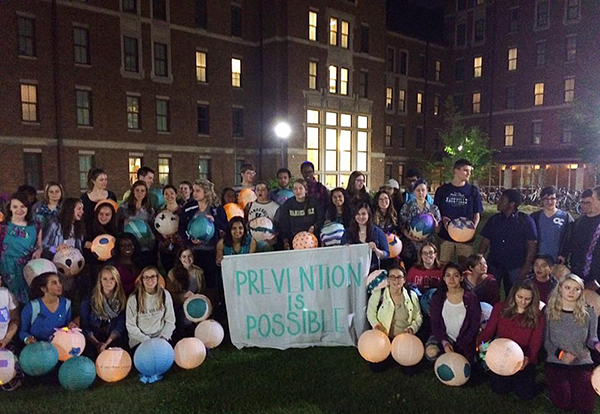
Cara at Vanderbilt University in Nashville, Tennessee
Tell us about your event
Our students were focused on supporting survivors, rather than wanting to voice anger or protest. We were striving to attract widespread participation that gave everyone a comfortable role to play.
For the beginning of the program, we came up with the idea of a silent procession. Most participants walk the route around campus, but we plan the route in advance to ensure it is wheelchair accessible. Students proceed silently, and many carry lanterns and wear glow bracelets or necklaces. Project Safe provides paper lanterns, in which we have glued LED tea lights.
In the weeks leading up to SAAM, student organizations, fraternities, sororities, athletic teams, and individual students can stop by Project Safe to pick up lanterns and decorating supplies. Students can decorate the lanterns in our conference room or take several to a floor, team, or chapter meeting. This encourages participation of multiple different student clubs.
What were some resources you used to organize and facilitate your event?
We promote the event through posters, email newsletters, student organization meeting announcements, and social media. We identify a central meeting place and time, and then a staff member leads the students on the route. We typically have a plainclothes police officer on hand, just in case there is any disruption.
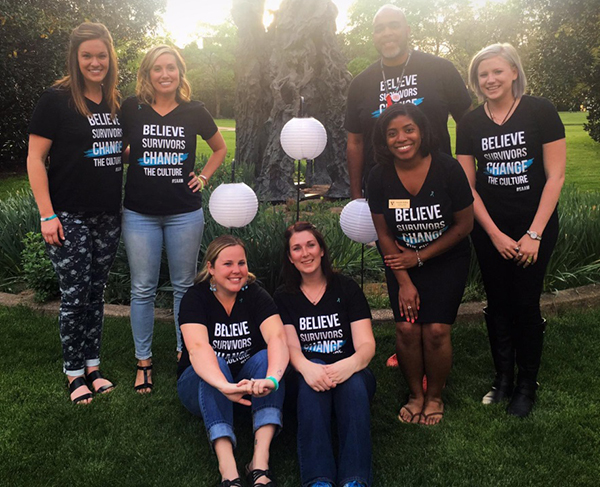
What advice do you have for someone planning a SAAM campaign/event for the first time?
- Give yourself permission to start small. Create safe, easy, broadly inclusive opportunities for people to participate as allies. Not everyone will be ready to identify as a survivor. And don’t quit if you only have a small turnout. Word of mouth will help next year’s event grow larger than the first one.
- Keep the visuals/branding clean and consistent. We try to limit our color choice to teal, with limited amounts of purple OR our school colors, but not all of these.
- Create a giveaway. Whether you cut and fold your own awareness ribbons and put them on safety pins or cut ribbon for people to tie around their bags or backpacks, this tangible item helped us identify ourselves and mention our cause.
- Know your target audience. Know your vibe. Tune into what your campus or community is feeling. Don’t try to force an event that you think won’t be appealing. If it’s not appealing, it won’t be persuasive, and what we’re really trying to do is change minds and behavior.
Tamara with Rara Rocks in Stockton, California
Tell us about your event
Rara Rocks was a gratitude rock painting party intended to generate awareness for sexual assault. The goal was to bring the community together and help victims feel comfortable speaking up and reaching out to their “rocks” and the free resources our community provides.
What was the planning process like?
I started to plan about a month or two in advance. When I was in group therapy at the Women’s Center, I learned that April was Sexual Assault Awareness Month. That was when I decided to create a campaign for our community and promote the Women’s Center services, which had been crucial in my healing. Plus, the resources they provide are free. It’s important for survivors to know that they can access these services free of cost since our community experiences high levels of poverty.
How did you promote the event?
I promoted on social media and had radio ads. The event was also featured on the local news and in the local newspaper.
What were some of the successes?
A success was bringing the community together. Local programs such as the Women’s Center Youth and Family Services, Child Abuse Prevention Council, and Fathers & Families were present to distribute resources. Another success was obtaining free advertisement! The local news reached out to me and covered the event the night and morning before the event. Also, the local newspaper interviewed me and ran an article on Rara Rocks. But as long as a victim/survivor was able to speak up to one of their “rocks” or someone from the organizations that were there, that was a success to me.
How could you make the event even better next year?
One thing I’ll improve for next year is making sure to book the venue in advance.
What advice do you have for someone planning a SAAM event for the first time?
Utilize your community resources. There are so many advocates that care and non-profits that will help support the cause. Also, don’t be afraid to ask for donations. I created a PayPal for Rara Rocks and promoted on social media so individuals could donate to help pay for the rocks, paint, and paint brushes. And finally, don’t be afraid to share your story to create a human connection with the community.
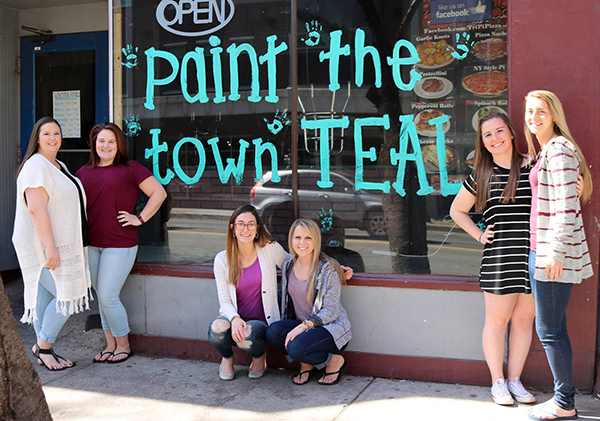
Christiana at The Women’s Center, Inc. in Bloomsburg, Pennsylvania.
Tell us about your event
The past two years, we have gotten groups of volunteers to go out in local areas of our county and window paint: Paint the Town Teal, #SAAM, and sexual assault statistics. Last year we did “Change the Culture.” Since we can’t window paint on the halls of our local University, we partnered with the Women’s Resource Center on campus who got teal ribbons laminated, and we hung them on residence halls and administrative offices.
What were some successes of your event?
This is the third year we’ve done this event, and it’s something that’s started to be recognized. Businesses expect us when we come around to paint and get excited about the possibility! Two years ago, the local news station even ran a segment about our event!
What advice do you have for someone planning a SAAM campaign/event for the first time?
Design a concise plan and grow over time. If you try to do too many things at once, you get spread too thin and don’t reach as many people. Also, reach out to your community partners early, utilize volunteers, and contact as many reporters as possible.
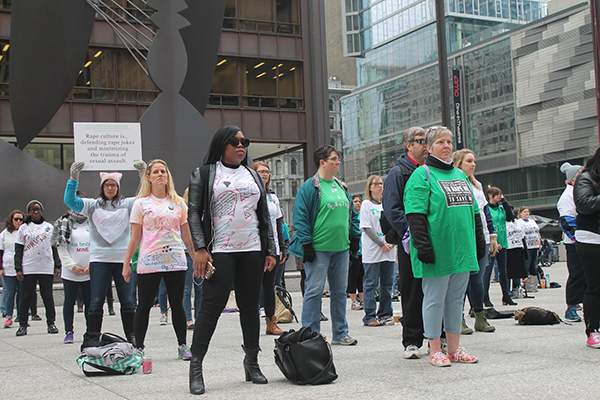
Lindsey at Resilience (formerly Rape Victim Advocates) in Chicago, Illinois
Tell us about your event
Standing Silent Witness is Resilience’s signature event for SAAM in Chicago (#SAAMChi). In a visual demonstration of the silencing of survivors of sexual violence, participants gather silently for one hour wearing t-shirts that bear stories and messages protesting rape.
What were the goals of this event?
Standing in solidarity, showing our strength in numbers, encouraging conversations, and increasing awareness.
Who was the intended audience?
The inactivated public and survivors who may feel isolated to show them that they’re not alone.
What were some successes of your event?
170 people joined last year’s event, which was our largest protest yet!
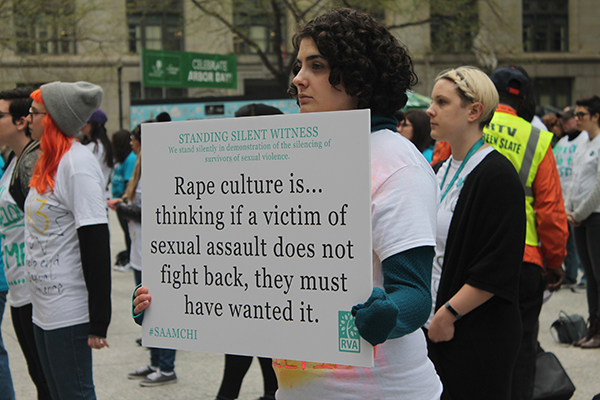
What were some resources you used to organize and facilitate your event?
We hosted t-shirt making parties the weeks leading up to the event to make sure multiple stories, statements, and stats were represented by those who stood with us. Social media and sending news tips to local media outlets really helped increase visibility.
Ann with The Center for Empowerment & Education (formerly the Women’s Center of Greater Danbury)
Tell us about your event
Teal ribbons were placed around trees in prominent areas of the towns we serve. Each had a laminated sign explaining what SAAM is and the services we provide the community. Our goal was to raise awareness of sexual violence and let our communities know about our services. We wanted survivors to feel empowered to seek support and know where to do so. For others, this was a reminder that there are free community resources available if they ever need to utilize our services in the future.
What was your planning process like?
We had to plan in advance, mainly so that we could reach out to the First Selectman/Mayor of each town/city to receive permission to hang up the ribbons. We also had to purchase the ribbons, print and laminate the signs, and safety pin the signs to the ribbons. We had a few volunteers that helped put the ribbons up in our 13 towns. We also had staff members put ribbons up in the towns that they lived in.
How did you advertise and promote the event?
We promoted the event through our social media accounts and email blasts, including pictures of the ribbons that were already up with prominent buildings/landmarks in the background for each town/city.
What were some of the successes?
Our successes were two media outlets covering the Teal Ribbons Initiative on their own accord, and multiple people taking pictures with the ribbons and tagging our organization on social media with their photos.
How could you make the event even better next year?
We bought satin wedding chair bow sashes instead of actual ribbon. These held up well in the weather compared to previous years where we bought actual ribbon. We also used safety pins to attach the signs, instead of a stapler, which worked well.
What advice do you have for someone planning a SAAM event for the first time?
Plan in advance and delegate responsibilities!
Tipheret with the Aurora Center in Minnesota
Tell us about your event
We held a candlelight vigil in the mall area of our campus to honor survivors of and victims we’ve lost to sexual violence. Then, we hosted an event that included performances by a university acapella group, a local spoken word artist, and a speech from a local survivor. We wanted to honor survivors and those we’ve lost to sexual violence. We wanted the kickoff portion of our event to appeal to a wide audience, yet still be centered on social justice and violence prevention. We hoped that it would raise awareness about the importance of violence prevention and believing survivors while getting people excited about the rest of the events we had planned.
What was the planning process like?
We started planning in early February. We decided what we wanted the event to look like by early March and started reserving the space we wanted, contacting folks to perform, and getting the supplies we needed. Our selection of performers was primarily based on the connections our office and volunteers had, which proved mostly successful. Aurora is mostly volunteer-based, so it wasn’t difficult getting our volunteers to help at the event.
How did you promote the event?
We created a small flyer that we sent to our partners on campus and passed out earlier that week during the National SAAM Day of Action, where we tabled outside and sold cupcakes to benefit our organization. We also created a Facebook event and shared it with our networks and on our organization’s page.
What were some of the successes?
Though we had some issues with the weather and miscommunication with the organization that reserves spaces on campus, we were able to move our event inside and adhere to our original schedule as best we could. The performers did a great job, and we had a pretty good turnout.
How could you make the event even better next year?
We definitely have to look ahead on the weather forecast, as the date of our event happened to be one of the coldest days of the month and made our vigil a bit more difficult. We also know now to reserve spaces on campus as early as possible to avoid any last-minute problems. Finally, we hope to continue to use campus groups and connections to find performers/speakers, and to possibly have performers do longer sets in the future.
What advice do you have for someone planning a SAAM event for the first time?
Make use of the resources available to you and make sure to market and publicize the event as much as possible. It’s easy to get overwhelmed about all the planning involved with a large-scale event, but it’s helpful to lean on professional staff or leaders who have organized similar events in the past. Also, plan early so you can reserve your space and performers well in advance.
Jacinda with The Philadelphia Prevention Partnership
Philadelphia, PA
Tell us about your event
For SAAM 2019, the Philadelphia Prevention Partnership hosted RAPE CULTURE: It’s Not in Your JEANS! The event was an open discussion among middle schoolers, high schoolers, and the community about sexual assault, rape culture, everyday consent, and surviving after sexual assault. We shared statistics and debunked cultural myths about sexual violence. Later on in the event, the girls were divided into groups and decorated their own jeans with drawings related to the topics we discussed.
What were the main goals of your event?
Our main priority was to educate community members about what resources are available if they or someone they know has experienced sexual violence. Secondly, we wanted to teach them how to practice everyday consent, whether it be giving someone a hug or sharing a photo on social media. We also wanted to get the community thinking about how they can use their voices to break the stigma surrounding sexual assault.
Describe the planning process
We only started planning about a week in advance. Since most of the materials we use are from the NSVRC website, it didn’t take long to put our event together.
What were some memorable moments from your event?
My favorite part of our event was when we had our first male volunteer send in his photo, which encouraged other men to support our campaign by sending in their own photos, too. Knowing that our event was supported by men in the community was very touching and empowering.
With our school-aged students, I think the most memorable moment was seeing the concept of everyday consent click in their brains. When we first started the session, everyone thought consent only applied to sexual acts. By the end of the event, they understood the meaning of everyday consent.
What was the main takeaway or message you hope attendees left with?
You don’t have to be a victim to speak out against sexual violence. We can use everyday practices to advocate against sexual violence.
What is one piece of advice you have for a first-time SAAM event planner?
Sexual violence is a tough topic to talk about. Not every event will be a huge success because people are afraid to talk about it, but don’t let that discourage you. We need to have these discussions.
Vickie with A Safe Home for Everyone
Jefferson, NC
Tell us about your event
Chalk the Walk is a community-based event where we use chalk to write and draw inspirational art on the sidewalks of Main Street. Messages of hope and awareness for survivors and their family and friends decorated the entire town.
Describe the planning process
We began planning several months in advance. Since we like to center many of our activities around the SAAM campaign theme, we usually wait until it is announced before we start advertising our event. We always find the SAAM toolkit very helpful in our planning process. We did a lot of social media advertising, mostly on Facebook and Instagram. We also wrote a newspaper article and appeared on local radio stations and talk shows to promote our event!
What were some memorable moments from the event?
The amount of support we received from community members and officials when presenting our ideas in front of town hall was heartwarming. Seeing so many people within the community come out and support our event made the experience all the more rewarding.
What was the main takeaway you hope attendees left with?
We wanted people to know that no one has to go through this experience alone and that your truth is the truth.
What is one piece of advice you have for a first-time SAAM event planner?
Get as many ideas from online as you can, take advantage of the materials offered in the SAAM toolkit, and plan, plan, plan!
Services Empowering Rights of Victims
Millville, NJ
Tell us about your event
We hosted the event Reading: A Journey Through Struggle to Healing. Local authors who have written about their experiences with sexual violence came to our community’s local bookstore and read excerpts from their books. After their readings, they signed and sold copies of their books to attendees.
What were the main goals of your event?
Our main goal was to teach our community about sexual violence and what they can do to help raise awareness during SAAM. We also wanted to make community members aware of the resources available to them within the community.
Describe the planning process
We started planning in early March. We promoted the event mainly on social media, but we also distributed flyers throughout the community. Word of mouth was definitely most helpful in garnering interest, so we made sure to let people know about our event everywhere we went.
What was the main takeaway or message you hope attendees left with?
Survival is possible. You are not defined by your trauma, and you can use your experience to become stronger and help others rediscover their strength after trauma.
What is one piece of advice you have for a first-time SAAM event planner?
Start early, and don’t be afraid to ask questions! There are so many resources out there; it can be intimidating trying to find them, so ask!
Hafeezah with Tri-County Speaks, (formerly People Against Rape) Charleston, SC
Tell us about your event
We participated in the Day of Action, which is a nationally celebrated day dedicated to sexual violence awareness. Our event was free to the public with the goal of providing a space for community members to share their agency resources and host activities to support survivors of sexual violence.
What were the main goals of your event?
We wanted community leaders to publicly share how they support survivors to make everyone in the community feel safe and welcomed. We also wanted to provide educational activities and resources about consent, sexual violence prevention, and how to support survivors.
Describe the planning process
I started planning our event in November. First, I compiled a list of community agencies we partnered with last year to reach out to again. I then scheduled individual meetings with each organization to discuss how we could expand and improve upon last year’s event. I found it most helpful to take time to get to know the communities you want to attend your events before the actual events happen. This helped to find locations that were most accessible to those without transportation and allowed the community to maintain a collaborative vision for the event.
What were some memorable moments from your event?
It was adorable watching the little kids coloring the consent coloring sheets. They absolutely loved them!
What was the main takeaway or message you hope attendees left with?
We hoped our guests would be able to not only learn more about PAR services but also learn about other local community resources and their roles in supporting victims of sexual assault.
What is one piece of advice you have for a first-time SAAM event planner?
Give yourself time to prepare. It is never too early to start thinking of event ideas and reaching out to organizations you’d like to partner with.
Planning a SAAM Event on a Budget
Planning a community event with a small budget can be a challenge, but limited resources don’t have to be an obstacle to participating in Sexual Assault Awareness Month. A small budget just calls for craftiness and creativity!
This list of suggestions and resources offers more budget-friendly ways of finding basic event-planning necessities.
Developing Graphics
Generating interest in your event starts with developing engaging and visually appealing graphics. Canva is a free online tool that has pre-made templates for almost any graphic you’d want to develop.
You can create items such as:
- Facebook posts
- Posters
- Flyers
- Brochures
- Facebook event covers
- Email headers
- And more!
Once you choose a template, you can upload your own photos or choose from their collection (some of which do cost money), change the color scheme, drop in whatever text you want, download, and print!
Advertising
Once you’ve made the perfect graphics, you’re ready to share them online and through social media. This can be a great way of getting your message out there, but it’s easy to get lost in people’s social media feeds.
- 16 Ways to Use Social Media to Promote Your Event gives advice on how to optimize your use of social media.
- 25 Ways to Advertise Your Event for FREE is a more general list of ways to spread the word. (Tip: the sections “For a Good Cause” and “Feed the News” are particularly helpful!)

Finding a venue
If you don’t have a lot of money to rent a space, you might have to get creative. There are usually cheap or free community resources available, however. For example, public libraries or churches will often rent out rooms for free – especially if it’s for a good cause.
- Free or Cheap Meeting Rooms covers cheap location ideas for your event.
Tabling
Tabling is a relatively cheap but effective way of spreading a message. It can be used to advertise an event in advance, or it can be the main event! You can spread information, raise awareness, or begin a network of volunteers.
Use whatever resources you have available to you. If you’re on a college campus, tabling is as easy as finding a spot to set up your fold-out table. If your focus is on a more general audience, reach out to local businesses like independent coffee shops.
Getting and sharing information
Google Drive and Google Forms are two incredibly helpful (and free!) resources.
You can use the Forms feature to create surveys to gauge the needs of your community, provide volunteer signups, or collect helpful information.
- Learn more about Google Forms here: Google Forms Guide: Everything You Need to Make Great Forms for Free
Google Drive is great for sharing materials amongst volunteers in a quick manner, which can save you a lot of time and hassle. Now Google offers Shared Drives, which are shared spaces where teams can easily store, search, and access their files anywhere, from any device.
- Learn more about Shared Drives here: What Can You Do With Shared Drives?
Free Food
Who doesn’t love free stuff? Having something to offer people – whether that be giveaways, candy, or food – can help get people excited about your event.
This can be a challenge when you’re strapped for cash, but many grocery stores and restaurants are willing to help out when they know they’re giving to a charitable cause.
- This letter template can be used to help encourage a local company to donate some free supplies; you can also use similar language if you want to request free or discounted use of a venue space!
We hope these resources and suggestions help put your mind at ease if you have a small budget for your SAAM event. Remember, you already have the most important resource: the drive to prevent sexual violence and create a safer, more equitable world for everyone.
Embrace Your Voice as a Leader

If you’re not usually the person at the forefront of community movements or events, the idea of leading one can be daunting. But planning an interesting SAAM event in your community calls for engaging volunteers in the planning process — and for someone to lead them.
Planning an event that will bring about real change this April means you’ve got to be your own Leslie Knope. Just remember this quote by Amy Poehler, “I just love bossy women. I could be around them all day. To me, bossy is not a pejorative term at all. It means somebody’s passionate and engaged and ambitious and doesn’t mind leading.”
With that being said, we’ve rounded up some suggestions for how to embrace your own leadership, encourage volunteers, and organize a successful SAAM campaign!
Start by identifying the reasons why the issue of sexual violence prevention is important to you. This will not only help motivate you to keep going during stressful moments, but it will also help you communicate a powerful and motivating message to volunteers.
Think about someone you’re fighting for, your vision for the future, a challenge you would like to overcome. What role do you – and volunteers – play in that journey?
Start reaching out to friends, family, co-workers, acquaintances, neighbors, etc. and ask them to meet with you individually.
Meeting with people one-on-one allows you to get to know them better, establish common interests and connections, and most importantly, ask them to join you. For instance, you could invite a potential volunteer to grab a coffee and chat about the skills they can bring to the table and what role they’d like to play as a volunteer.

When asking someone if they’re willing to help organize or volunteer for an event, it’s helpful to be direct. Ask them whether they’re willing to help and wait for the response. There’s no need to be apologetic or coy.
Be specific in what you’re asking for. Having a concrete question lets the person know what exactly they’re agreeing to and helps get the ball rolling in the planning process.
Establish a game plan before you conclude meetings with volunteers. Decide when the task(s) need to be completed, how you’ll communicate with one another, and what exactly needs to be done. You can even ask them if they have any recommendations for others who might want to help!
Listen to the needs and concerns of your volunteers. In order to make a campaign successful, the volunteers need to be invested and enthusiastic. If they aren’t being heard, they will be less likely to help in the future.
Try delegating responsibilities, not just tasks. When someone is in charge of overseeing one aspect of a campaign from start to finish, they develop a stronger sense of ownership over their duties and a greater feeling of pride when they see it completed. Additionally, it takes some of the burden off of you by knowing that there’s always the same person to turn to for specific needs.
SAAM Campaign Ideas for Your Community
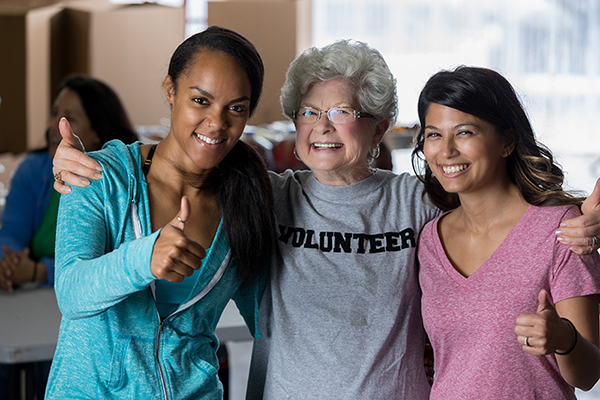
There are lots of different ways to spread awareness about sexual violence prevention this April. Whether you already work for an organization that participates in Sexual Assault Awareness Month or you’re an individual looking for ways to engage your community, these seven simple ideas can help spread awareness and promote healing for survivors.
Awareness Table
Awareness tables are a great way to interact with the public face-to-face. Many positive interactions come from putting a resource in someone’s hand and educating them on the issue while tabling. You can answer questions as they come up and even collect their email address to follow up with more information.
Many businesses are happy to help out community members if they know that you are working for a valuable cause. Reach out to local businesses or organizations and ask if you can set up a table to spread awareness for a day or two throughout the month. Decorate your table with teal, distribute campaign resources, and offer SAAM products like teal ribbon temporary tattoos or giveaways.
Movie Screening
Movie screenings are an engaging way to open dialogue about sexual violence with members of your community. Seek out local theaters or community spaces that have a projector and ask about hosting movies that address the issue of sexual violence during April for free or at a discounted price.
Use discussion guides to get the audience talking about the issues addressed in the film, or ask a panel of local experts to participate. You can even create a Facebook Event for the film screening and use the discussion section to open up conversation before the film.
Library Display Case
Talk to your local librarians and ask to put together a display case of books and DVDs that address sexual assault throughout April. You could create a sign that explains what Sexual Assault Awareness Month is and provide the contact information for your local rape crisis center and other available resources.

Restroom Campaign
Everyone stares at the back of public restroom stall doors, so it’s a great space for outreach. You could focus on topics like consent, believing survivors, or how to be an engaged bystander. Download and print our campaign poster or design your own with information on local resources or ways to get involved. Then put them up in the restrooms at college campuses, bars, businesses, and state agencies (with permission, of course).
Policy Advocacy
Participate in political advocacy during SAAM by writing letters to local, state, territory, tribal, and national government officials about policies related to sexual violence that impact your community like rape kit backlogs and statutes of limitations.
Provide information and templates to community members – including young people – to encourage them to participate in this campaign.
Engage Faith-Based Communities
If you’re a member of a religious community, you could ask your faith leader to address sexual violence during services, offer prayer sessions for survivors, or host educational programs throughout the month of April on topics like healthy relationships and healthy masculinity.
A church bulletin is a perfect space to highlight the contact information for your local rape crisis center. You could also organize a bake or craft sale with members of your faith community and donate the proceeds to your local rape crisis center.
NSVRC has developed this shareable resource for faith leaders that details ways that they can get involved with sexual violence prevention.
Get Moving
Many social and health causes have started annual walks/runs to raise money and awareness. You can plan a walk for sexual assault awareness or reach out to other organizations that are holding walks/runs to form a team representing the anti-sexual violence movement. Consider collaborating with a local studio or a YWCA to host a Zumba, yoga, or dance class. Donate the money you collect from the class to a local rape crisis center.
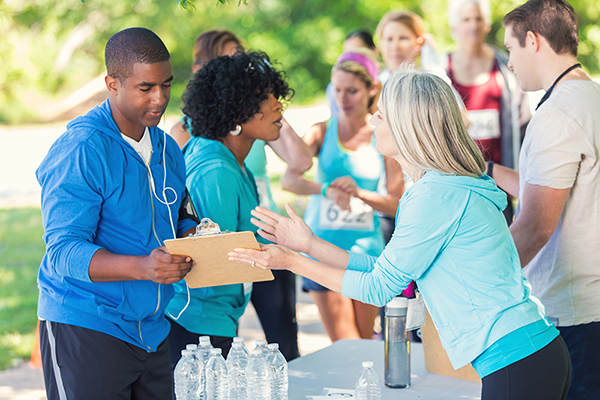
Remember, there’s no one “right” way to get involved in Sexual Assault Awareness Month. Think of your resources, availability, capacity, and goals when determining which event or events would be a good fit.
Organizing something like a display case at your local library won’t require a lot of your time but can have a big impact. The important thing is that you are getting engaged and showing your support for survivors and taking steps toward ending sexual violence once and for all.
This list highlights just a few of the countless ways you can bring SAAM to your community. For a more comprehensive guide, check out the Event Planning Guide from our 2019 campaign which still has relevant ideas and tips.
How to Engage Your Campus in SAAM

College is a great time to get involved in social movements; you’re surrounded by passionate young people and have access to lots of free campus resources. It’s particularly important for college students to be active participants in the fight against sexual violence since campus assault is such a widespread problem.
You can be the leader your college or university needs to bring a SAAM event to your campus community. Not only will you be showing your support for survivors but you’ll be helping prevent sexual violence before it happens. Here are some suggestions for how to engage your campus this April.
Partner with other organizations
There are most likely groups on your campus that are already interested in the movement to end sexual violence. Reach out to them and see if they’d like to partner together for an event.
Here are some suggestions for groups to look into:
- Feminist collectives or clubs (e.g. chapters of I am That Girl)
- Clubs that promote healthy sexuality/safe sex
- Chapters of the American Association of University Women
- Community service groups (e.g. AΦΩ)
- Women and gender resource centers
- Greek life
Review the campus sexual assault policy
Every college and university should have their sexual misconduct policy available online. Take time this April to review the document and make sure it allows victims fair access to justice and resources.
Here are some things to look for when reading your school’s conduct policy:
- Are the services and procedures accessible to students of every income, race, sexual orientation, gender identity, etc.?
- Are students given the option of reporting sexual assault confidentially or anonymously?
- Does the policy clearly indicate how the school confirms that the policy is being carried out correctly? Does it outline a method of enforcing the policy?
- Does the policy grant victims amnesty? That is, are victims that may have violated other policies (such as drinking) at the time of the assault given immunity from discipline when they report the incident?

If you find something that should be improved, you could start a petition to have the policy altered. Make suggestions for specific changes and raise your concerns with the Dean of Students and/or College President.
Reach out to your campus newspaper
Ask the newspaper to post about upcoming SAAM events on campus or submit an op-ed or a letter to the editor.
Update your coffee sleeves
Reach out to the director of dining services and ask if they’d be willing to replace the coffee sleeves used in campus dining locations during the month of April. This is a great way to – quite literally – put information about SAAM in the hands of your peers. You could put prevention messages on the sleeves, such as “I believe you” or provide information about services for survivors. For example, here are our I believe you lanyards which could be warn by staff.
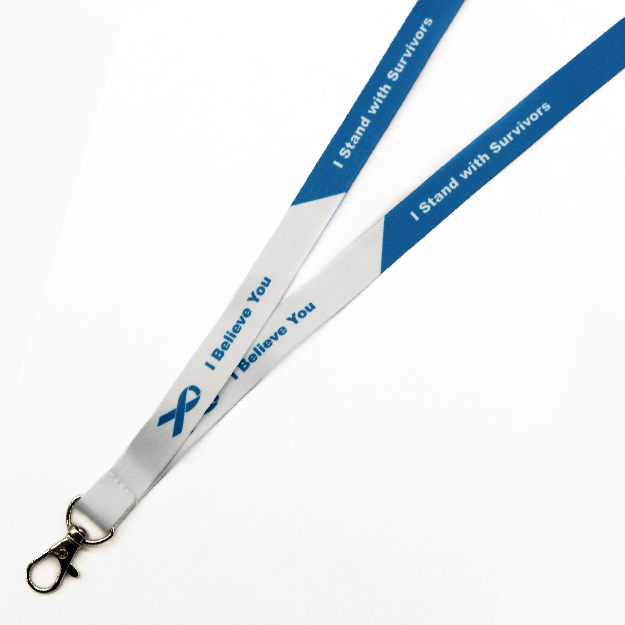
You could partner with a local rape crisis center to buy some in bulk, or you could make your own like this university did!
Get Your RAs Involved
Resident Advisors (RAs) are there to help residents feel safe and comfortable, so it’s important that they have the right tools to do so.
Here are some ways to engage RAs:
- Ask them to address consent during their monthly resident meetings.
- Ask the Title IX Coordinator or someone from a local advocacy group to give a seminar on identifying signs of abuse and tactics for intervening.
- Coordinate a seminar about how to respond if one of their residents were to disclose an instance of assault to them.

Giveaways
College students love free things! You can attract people to your event or informational table with something people can take, even if it’s just homemade cookies. This act can create an awareness domino effect by drawing other people’s attention to the issue.
Ultimately, you know your school best. Think about the needs of your campus and what people like to see or engage with. Think about some events you’ve been to on campus that were successful. Reflect on what made them successful and how you can follow that example.
Movies to Screen During SAAM
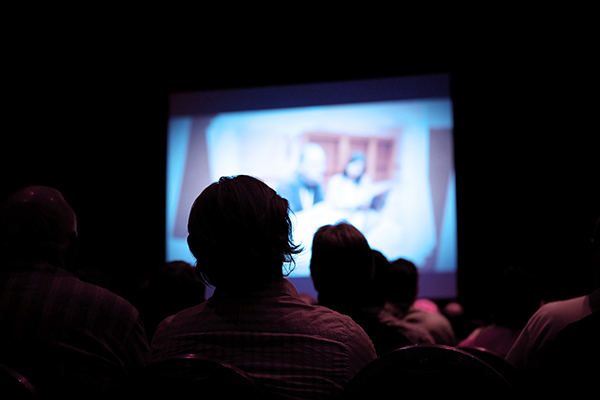
Movie screenings are a relatively easy way to start a conversation about sexual violence. Simply connect with your local movie theater and see if they’d be interested in hosting a screening in honor of Sexual Assault Awareness Month. After you’ve found a location to hold your event, you’ll also want to consider how to promote your event and how to make the most of the screening.
Licensing Fees
You should be aware that you will need to pay a licensing fee to show a movie in a public space. The theater you connect with should be able to direct you to the proper channels to legally screen the film. The fee to screen the film will vary depending on what you’re showing and other variables (like audience size, location, etc.), so you may want to look into a few options to see what would best suit your budget and needs.
Promote Your Movie Screening
Create a Facebook Event for the screening and include basic information like the location and time. Invite your friends to the event and encourage others to share the event so you reach as many people as possible.
If you’re planning on having a panel discussion after the screening, you could encourage attendees to ask their questions ahead of time on the discussion page. You can also use the event page to provide key information like a suggested arrival time, the time the movie will begin, and the time of the post-screening discussion.
Of course, you can also go “old-school” and make posters promoting the screening and hang them around your community. The important thing is that you make your screening worthwhile by filling as many seats as possible!
Make the Most of Your Movie Screening
A movie screening can do so much more than just entertain. Consider having a table set up as attendees come in the doors. You could hand out SAAM materials (such as palm cards, posters, or one-pagers) and offer information about your local rape crisis center. You can also enlist future volunteers by collecting email addresses.
Before the film begins, you might have the event organizer make some opening remarks on the importance of the screening and educate the audience on ways they can get involved in Sexual Assault Awareness Month beyond attending the screening.
After the film, you might consider hosting a post-screening discussion. You could ask local experts to weigh in on the topics portrayed in the film and allow audience members to ask questions.
Choosing Your Movie
The movies you choose and the type of event you host will all be dependent on the needs of your community. There are countless films that deal with sexual assault either directly or indirectly, but we thought we’d get you started with a few ideas.
Here are ten movies that address issues of sexual violence from various perspectives.
The Hunting Ground
PG-13 – 1h 34min – Trigger Warning: campus sexual assault
The Hunting Ground depicts rape on college campuses, the emotional turmoil the assaults inflict on survivors and their families, and how administrations have worked to cover up the cases.
Here is an example list of potential discussion questions you could pose to the audience after the film.
Anita: Speaking Truth to Power
Not Rated – 1hr 17 min – Trigger Warning: sexual harassment and racism
Anita Hill’s allegations of sexual harassment against U.S. Justice Clarence Thomas became a national scandal. This documentary discusses the various societal factors at play that blocked Hill from receiving justice.
I AM EVIDENCE
Not Rated – 1hr 29min – Trigger Warning: sexual assault
This documentary follows the stories of survivors seeking justice through the courts. It illuminates several failures of the U.S. criminal justice system and the disturbing backlog of unexamined rape kits.
Spotlight
R – 2hr 8min – Trigger Warning: child abuse
This crime drama follows a team of journalists who uncover child sexual abuse in the Catholic Church and the Church’s complex cover-up of the scandals.
Here is an example list of potential discussion questions you could pose to the audience after the film.
The Invisible War
Not Rated – 1hr 33min – Trigger Warning: military sexual assault
This documentary investigates the rape epidemic in the military, the systematic process of hiding these cases of assault and the devastation that follows.
Here is an example list of potential discussion questions you could pose to the audience after the film.
Audrie and Daisy
Not Rated – 1hr 35min – Trigger Warning: assault and bullying
Audrie and Daisy is a documentary that looks into the fear, isolation, bullying, and harassment that victims of sexual assault experience in high schools across America.
Here is an example list of potential discussion questions you could pose to the audience after the film.
Precious
R – 1hr 50min – Trigger Warning: sexual assault and incest
This heartbreaking but hopeful film shows the journey of a young woman growing up in an abusive household. This movie shows the struggles of speaking out and escaping domestic abuse and violence.
Roll Red Roll
Not Rated – 1hr 20min – Trigger Warning: rape
This true-crime documentary takes a deeper look into the Steubenville, Ohio high school rape case and examines themes of toxic masculinity that reinforce rape culture.
Surviving R. Kelly
TV-MA – 6hr (6 episodes) – Trigger Warning: sexual abuse and assault
Surviving R. Kelly is a 6-part Lifetime mini-series, detailing the stories of women who have come forward with their experiences as survivors of sexual abuse from R. Kelly.
How Social Media Can Amplify Your SAAM Message

The fast pace of social media and its constant flow of information makes getting noticed difficult. With the right tools, however, social media is a great way of getting people to join your SAAM campaign and attend events.
So if you’re hosting a SAAM event, here are some ideas for maximizing your visibility and appeal on social media.
Change your cover photo to advertise your event or campaign. Whether you’re coordinating a campaign as an organization or as an individual, creating a new cover photo is one of the most basic ways of spreading the word.
Create a highlight reel of your SAAM campaign last year to help give people a sense of what to expect of this year’s campaign and inspire them to get involved.
Free online tools like Adobe Express make it simple to create short, captivating videos. Using catchy audio and fun visuals is a great way of getting people excited about the prospect of participating! You can share your photos or videos on all major social media platforms including Instagram, Facebook, and Twitter.
Make visually appealing testimonials. Using tools such as Canva, you can create beautiful graphics with quotes from people who have participated in your previous SAAM events. Showing an outsider’s praise gives your campaign more credibility.
Use one hashtag for all social media platforms. Having a single hashtag makes it clearer what to use when people want to post about your event, and it makes photos easier to find. Of course, you can always use the official hashtag of Sexual Assault Awareness Month, #SAAM, in more general posts during the month.
Post pictures of speakers you have at an event(s) with quote overlays. This is a visual way of advertising your event and getting people excited about what the speaker has to say. You can (and should!) tag the speaker so that the post will be visible to their followers as well!
Create a Facebook event page. This one is pretty obvious, but having a central page you can link to and share information about events in your campaign is crucial.
Make a reel or Instagram Story. Share your plans and activities with your online followers and encourage engagement.
Advertise your event in your email signature. If you have to send emails for work regularly, this is a great way to plug your event without having to mention it directly!

Utilize the Facebook Live feature by streaming your SAAM event to your Facebook audience as it’s happening. Facebook algorithms that decide which posts to prioritize prefer live videos.
Participate in the #30DaysofSAAM Instagram contest to engage others in a fun and creative way. Follow @NSVRC on Instagram to get daily prompts during the month of April and then respond to them with a photo using #30DaysofSAAM and tag @NSVRC. Check our account at the end of each week in April to see if you’ve been chosen as a finalist or winner to receive a prize pack of SAAM merch!
Utilize the SAAM Social Media Guidance. The toolkit has sample posts, advice on how to make the most of each social media platform, and more! You can also use the campaign share graphics, which are sized for each platform.

